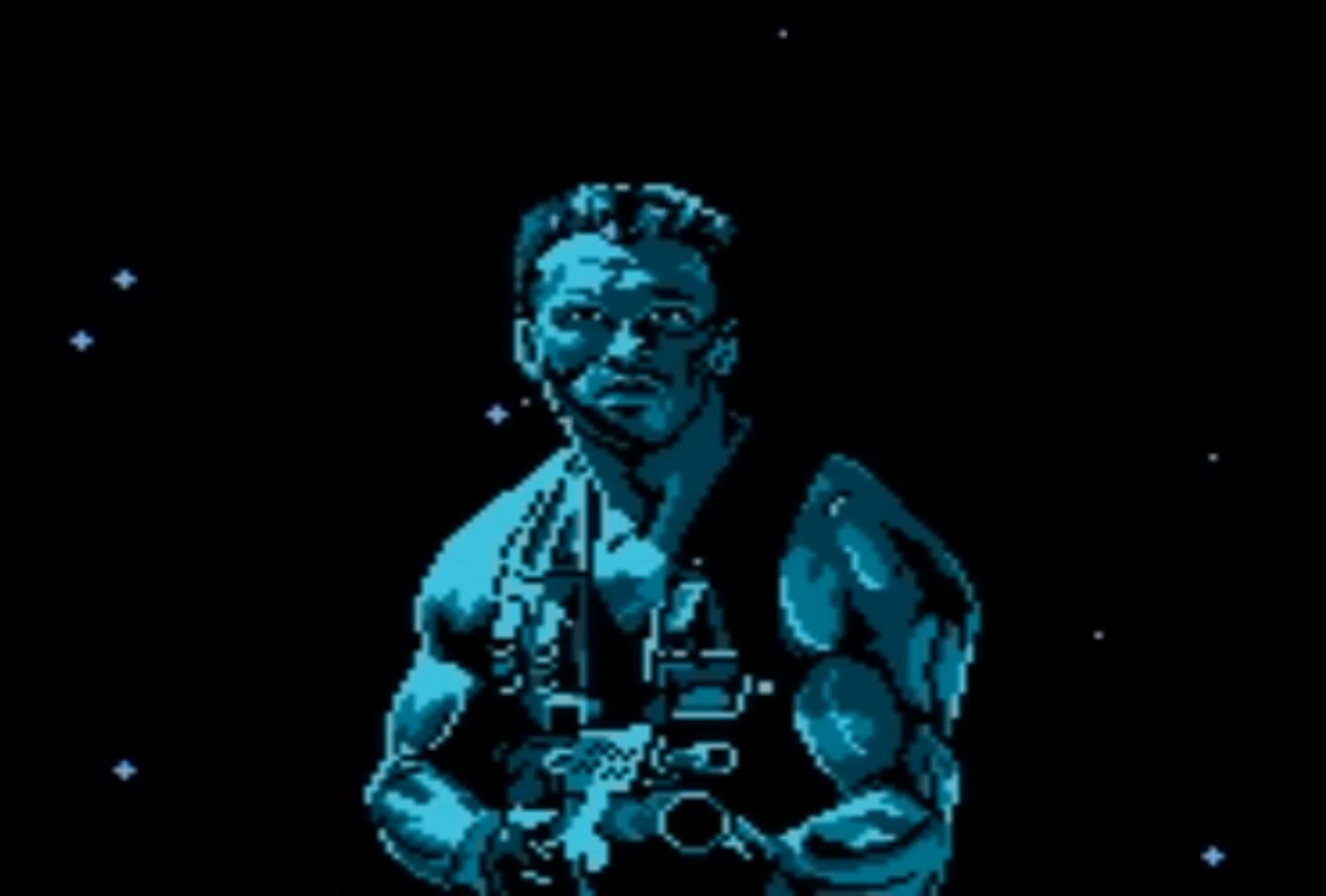The shockingly great Prey has everyone buzzing about the Predator franchise again. As millions enjoy the opportunity to celebrate the highs of that franchise once more, though, I can’t help but throw a little cold water on the party by discussing one of the worst and weirdest things to carry the Predator name. No, I’m not talking about Aliens vs. Predator: Requiem (who wants to do that?), I’m talking about the 1988/1999 NES game based on the original Predator film.
If you didn’t know that there was an NES game based on Predator, then take comfort in the fact that you belong in the ranks of the happy many. There are dozens (if not hundreds) of NES games that are still being discussed all these years later for one reason or another, and Predator generally isn’t one of them. It’s a game that most are all too happy to forget about if they even knew about it in the first place.
Yet, I’d argue that Predator deserves some kind of place in the modern conversation about classic video games. After all, it’s a game that so perfectly captures a very weird time to be a gamer.
Predator Reminds Us Of a Time When Protagonists Looked Nothing Like the Character They Were Based On
We all know that the NES was not a powerhouse piece of gaming hardware. While there were some legitimately great-looking NES games, Nintendo’s first home console wasn’t exactly known for its realistic visuals. Honestly, we wouldn’t start seeing human video game characters that actually looked like humans until sometime closer to the early 2000s.
Having said that, we also know that there were quite a few NES developers that weren’t exactly trying their hardest. At a time when getting a game on shelves was often more important than getting it right, many corners were cut in the pursuit of “good enough.”
All of that is just my way of introducing you to the majesty of Dutch’s (aka Arnold Schwarzenegger’s) character model in the NES adaptation of Predator:
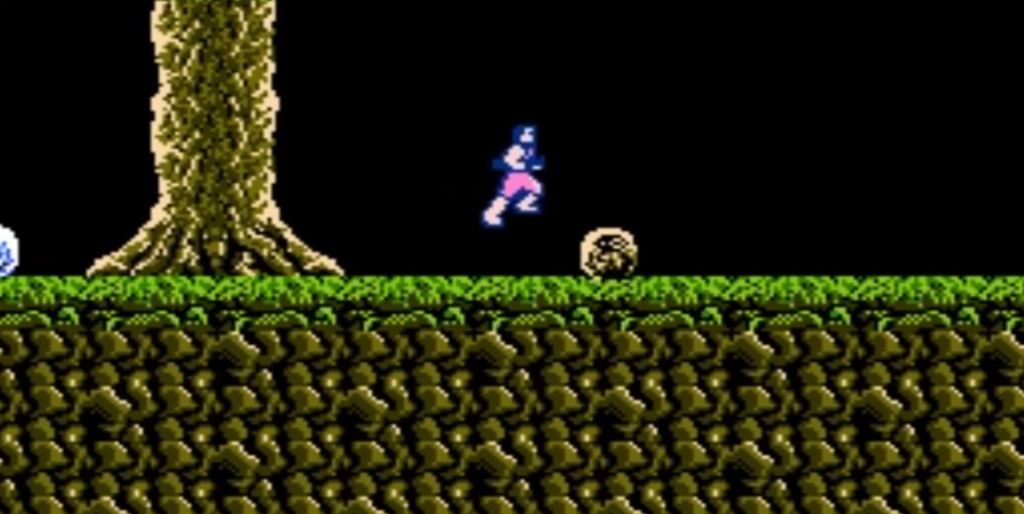
Look, I’ll be the first to admit that there’s nothing more badass than fighting a renowned alien warrior in the jungle while wearing a hot pink jumpsuit. Maybe Dutch went a little too far when he decided to dye his hair blue and throw on some peach boots before embarking upon a classified search and rescue mission, but at least that color combo might confuse the Predator’s heat vision sensors.
My big question about that design decision is “Why?” Not since the glory of Jason’s purple and blue outfit from the Friday the 13th NES game have we seen a studio’s artists go so far out of their way to dump a bucket of neon on an intentionally drab character. Then again, that kind of was the fashion at that time, especially when it came to games based on popular properties. If Requiem for a Dream was an NES game, we’d probably see Ellen Burstyn’s character wander around a Pac-Man-like maze looking for pills while wearing a bright orange nightgown.
It’s often been said that the main reason why some NES developers made their character models so colorful was simply to make them easier to see. However, I have to dispute that claim somewhat. Not only were there plenty of soldier characters in popular NES games that were easy to see despite wearing grey, brown, and green, but we know for a fact that the NES was capable of rendering a character model that at least kind of looked like Arnold Schwarzenegger. Even the terrible Total Recall NES game featured a version of the actor that looks like it was drawn by someone who at least saw the poster for an Arnold Schwarzenegger movie:
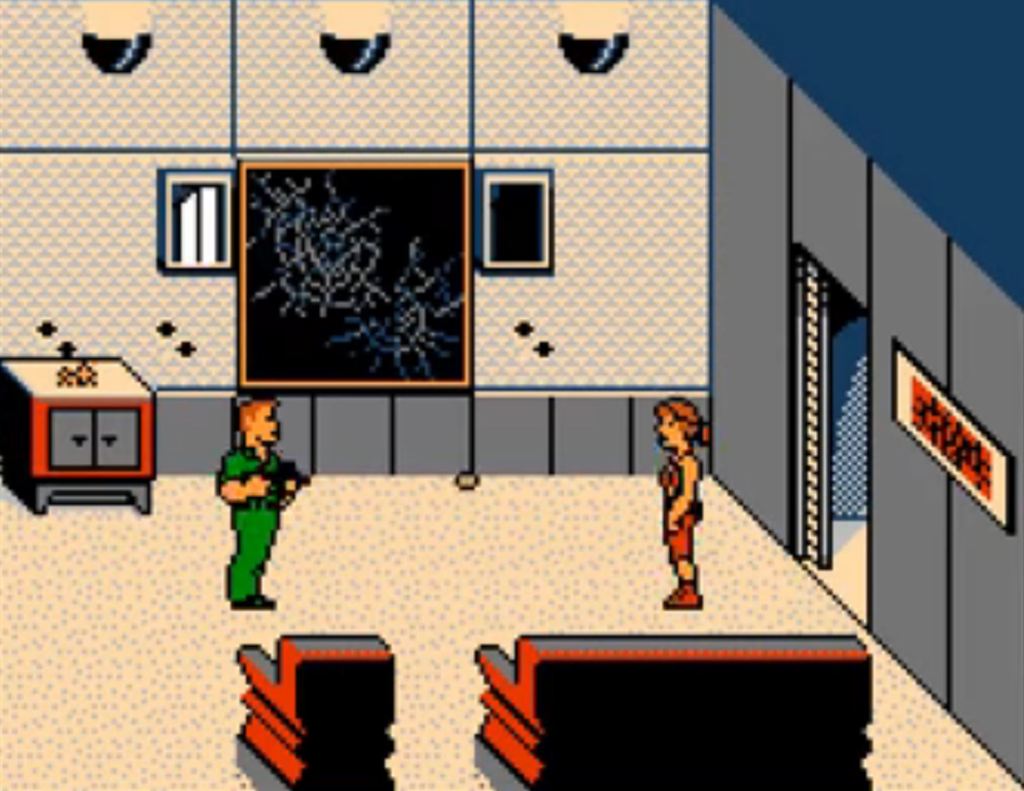
Still, the sad truth is that Predator’s character design is more representative of the effort that went into the average licensed NES game. My nostalgia wants to convince me that we thought those games were the best-looking things ever, but that’s just not true. The sight of a bright pink special ops soldier standing in the place where Arnold Schwarzenegger should be was just as confusing in 1989 as it is now. Indeed, a big part of growing up with crappy NES games was learning that the universe was not above scamming children.
Speaking of scams…
Predator Conned Everyone Into Thinking It Looked Like a Real Video Game
You may be wondering how so many people could have possibly been surprised by Predator’s pink protagonist. After all, surely the back of the game’s box at least showed a snippet of gameplay that let everyone know what they were in for, right?
Wrong. While authentic and in-tact versions of Predator‘s NES box are hard to find (go figure), this Reddit photo of the game’s original box art does a good job of showing what many people at the time had to go off of when they were thinking of buying the game:
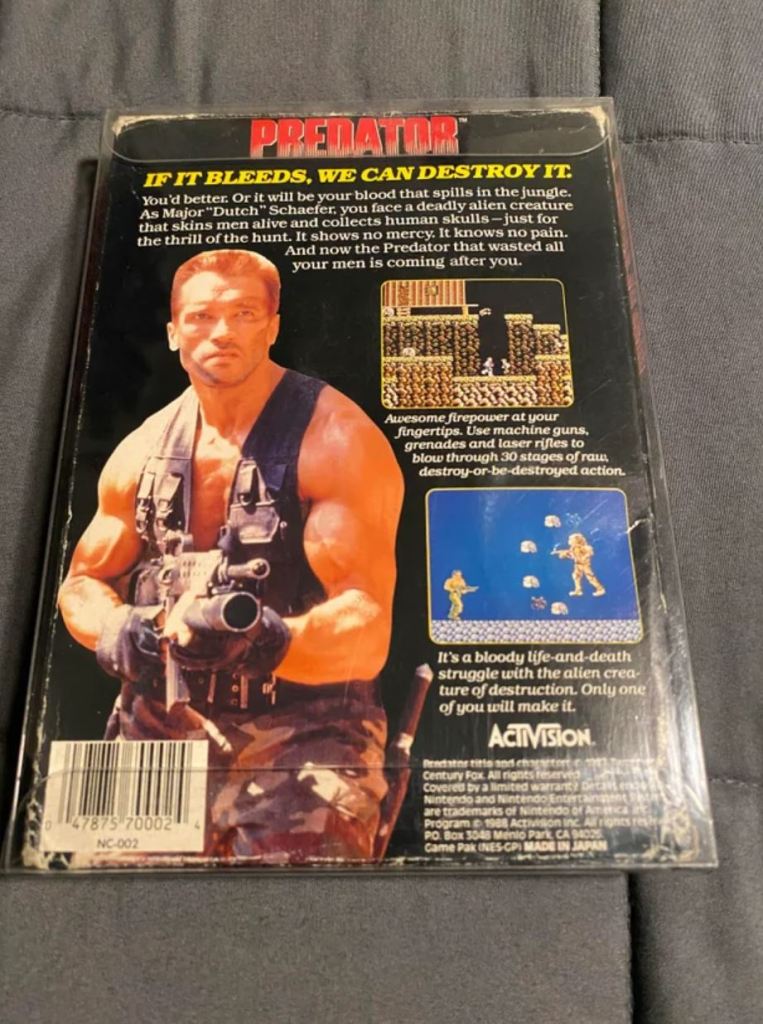
From what I can tell, it looks like that top screenshot of the game features a more “realistic” character model that is actually based on the visually superior MSX2 version of Predator. I’m not sure if it’s directly pulled from that version of the game or if a new character model was created specifically for advertising purposes, but I can tell you that someone clearly knew that it would be a bad idea to showcase the actual character model in its full pink glory.
You may also think that the shot at the bottom of the box that clearly shows a better-looking game must also be from the MSX2 version of Predator. However, that’s actually a screenshot from an NES-specific feature lovingly known as “Big Mode.”
The good news is that Big Mode features a version of Dutch that actually looks like Arnold Schwarzenegger (well…close enough). The bad news is that the game compensates for that sudden turn towards respectability by forcing you to participate in auto-scroller shooting sequences that might just be the most embarrassing thing that Arnold Schwarzenegger has ever appeared in.
In a better game, those sections would have offered a little variety. Here, though, they serve one clear purpose: to offer a mode that the marketing team could use to fool people into thinking Predator looked like a game you might actually want to play.
Even still…Big Mode? Out of all the incredible NES action games that were just waiting to be ripped off, the Predator NES team decided that Big Mode was their chance to think outside of the box and try something different. What’s worse is that the Big Mode sections come along without much warning or set-up. One minute, you’re regretting your decision to rent/buy the Predator NES game, and the next minute, you’re suddenly playing something else entirely. For a few glorious moments, you think that you’ve unlocked a better game. That brief sensation of optimism is soon extinguished by the quality of the thing itself. Anyone who has tried to watch Predator 2 will know what I’m talking about.
Do you know what’s really strange, though? While that mode would have kind of made sense if it was limited to Predator boss fights, you actually fight the Predator several times during the game, and only some of those fights take place in Big Mode. Impressively, that’s not even the weirdest thing about the game’s roster of enemies.
Predator Showcases the Many Struggles of Turning Movies Into NES Games
If you know anything about the history of bad NES adaptations, it won’t surprise you to learn that the Predator NES game had to make quite a few changes to the source material. In and of itself, that’s not a big deal. Even more modern video game adaptations have to play with the source material a bit in order to make the whole thing work as a video game.
Even still, I can’t make peace with the fact that the developers decided to have you spend the majority of your Predator adventure controlling a hot pink soldier who uses a variety of human and alien weaponry to shoot at scorpions, birds, and other things that should not be considered an actual threat in any way. Just look at some of the “enemies” in this game:
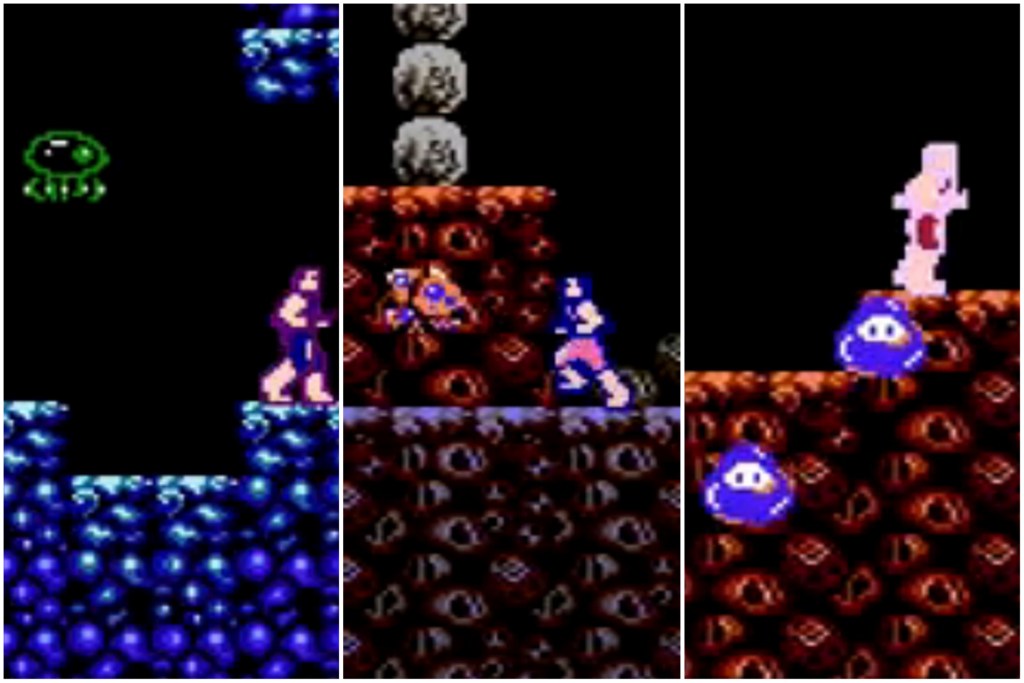
I have two possible explanations for this sad state of affairs. The first is based on the idea that Dutch and his team pissed off Mother Nature so badly when they mowed that small section of the jungle down in the movie that Mother Nature decided to seek revenge. The second is based on the much more logical possibility that the game’s developers didn’t want to fill the NES title with human soldiers (such as we saw in the MSX2 version of the game). Sure, they may be adapting one of the bloodiest action movies ever released up until that point, but someone has to think of the children.
What’s really strange, though, is that the NES version of Predator does feature human enemies. It’s just that most of them are found at the very beginning of the game and again during random later sections. While you can kill them, there’s really no reason to do so. Most of them will actually run off cliffs and deny you the pleasure. Maybe they were so scared of being hunted by the Predator that they chose to simply leave the jungle as quickly and permanently as possible. Of course, I imagine the sight of a soldier in bright pink gear punching scorpions in the face will drain your will to fight fairly quickly.
Speaking of the Predator, there are actually three kinds of Predator boss fights in this game. The first is the aforementioned Big Mode battles that are as thrilling as the three frames used to animate them suggest they would be. The second kind of Predator boss fight sees you battle a smaller sprite of the creature that looks like this:
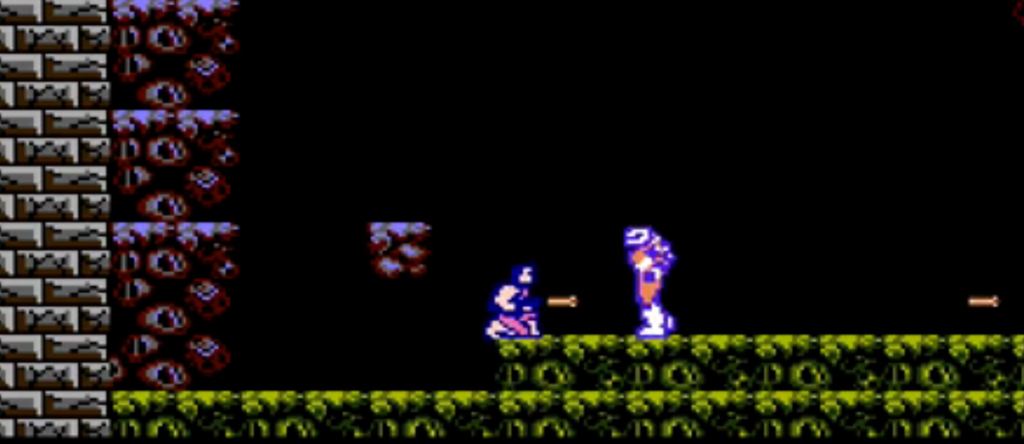
While I’ll happily read any piece of fan fiction that argues that these two are actually fighting because they wore the same outfit to the same party, I can’t rightfully call those boss battles a “fight.” After all, the Predator barely even shoots at you during those encounters. He instead spends most of his time jumping in the air, doing a few flips, and then landing straight on his ass. You actually fight a few different versions of that Predator throughout the game, and (aside from some welcome costume changes) they all behave roughly the same way. That is until you meet this “final form” version of the Predator which serves as the game’s climatic boss fight:
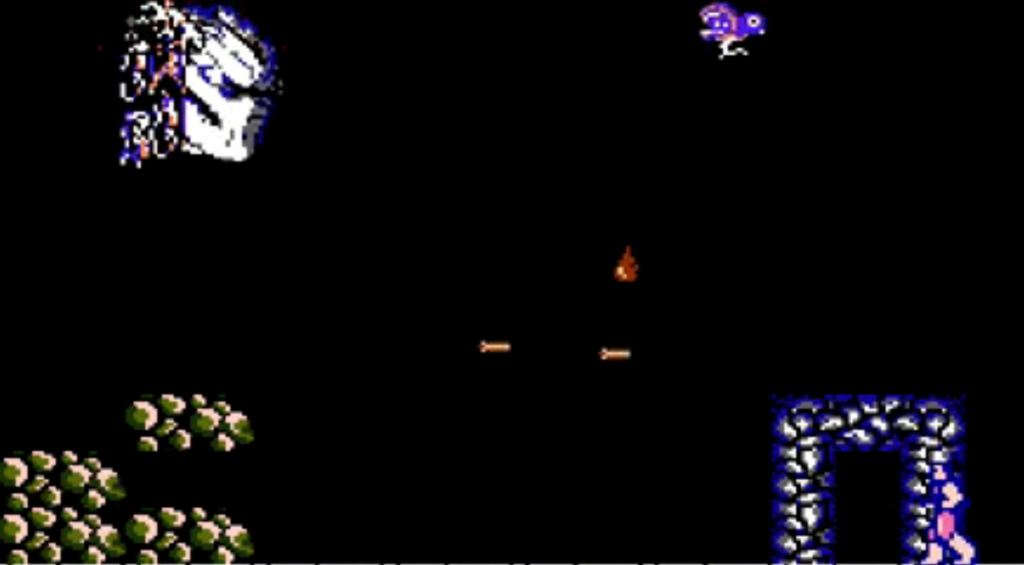
While many video games of that era found it difficult to resist the allure of a giant floating head boss fight, I find this one to be especially hilarious. After all, we see two distinct versions of the Predator throughout the game that appear to be largely intact. What happened to the Predator to make it a giant floating head, and why is that floating head so much tougher than the full versions of the same creature?
For that matter, why do you defeat the final form of the Predator with a laser gun when the actual final fight against the Predator saw Dutch go back to basics? Are we to believe that the NES version of Dutch dismembered the Predator, watched in horror as the creature’s head rose up against him, and then used the Predator’s own arm canon against it? If so…well, could someone recreate that sequence in the next Predator movie, complete with a fluorescent pink jumpsuit?
By the way, I hope you’ve enjoyed this brief look at the Predator’s final form. After all, few who actually play the NES game will ever get to see it for themselves.
Predator Was So Confusing, Difficult, and Broken That the Game Needed to Include a “Suicide” Button
It shouldn’t surprise you that the NES version of Predator is a difficult game. The phrase “NES hard” exists for very good reasons. What may surprise you are the specific reasons why Predator is as difficult of a game as it very much was.
Most of your deaths in Predator won’t come from the game’s bizarre gallery of enemies. Instead, the biggest danger in the game is often having no idea where to go or what to do. See, Predator is kind of like a Metroidvania game in the sense that it forces you to navigate complex labyrinthian levels. Unlike a Metroidvania game, though, most of the paths through Predator are as dangerous as they are because they’re filled with pinpoint precision platforming jumps, invisible pits, and hidden paths that lead to nowhere. There will be many, many times when you’ll find yourself hopelessly lost in this game. Even worse are the times when you’ll literally not be able to progress any further because of a bug or a wrong decision that you made a few screens back.
That brings us to the real number one cause of death in Predator: the suicide button.
Yes, if you press A or B while Predator is paused, you can simply choose to end it all and start over again. The only possible reason for that feature to exist is that the developers knew it would be the only way to get past some of the many game-breaking scenarios you’ll encounter throughout your Predator journey. Mind you, Predator isn’t the only NES game to include that pathetic feature. It was actually a surprisingly common feature among some of the NES’ absolute worst titles.
Yet, I feel like Predator’s use of a suicide button may be the most unnecessary. Mind you, that’s not because you won’t have to use it (you most certainly will) but rather because this game didn’t need to be nearly as complicated as it was.
Simply put, Predator should have just been a shameless rip-off of Contra. At the very least, Predator should have been the simplest NES action game imaginable. All anyone wanted from a Predator game at that time was an excuse to run around as Arnold, mow down waves of soldiers, and occasionally (or eventually) battle the Predator. This game never needed to be anything more than that. So why did the Predator NES team feel the need to go so far out of their way to make that version of the game so much more complicated than it ever needed to be? Why was a game that was clearly primarily intended to be a cash-in so weirdly elaborate?
It’s our inability to logically answer those questions that makes Predator a magical experience.
Predator isn’t necessarily the worst NES game ever, nor is it the most difficult or even straight-up strangest entry in that console’s historical library. What it is, though, is this perfect representation of the things that made that era of gaming so very weird.
In what other console generation would a studio called Pack-In-Video get to make a game based on one of the biggest movie properties available at the time? In what other era would so many studios try to sell so many games based on Rated R movies to audiences of mostly younger gamers? What other historically successful console is home to so many games that were so loosely based on movies that they might as well have been based on nothing at all? For that matter, what other historically successful console was filled with so many major games that were honestly little more than outright scams?
You won’t find Predator on any respectable list of essential NES experiences. In its own way, though, the game is an essential NES experience. It’s the kind of game that perfectly shows the other side of NES gaming that we’d all rather forget about. You may not have grown up with a copy of Predator for the NES in your house, but you probably owned several games like it. They were the games that forged a generation of gamers who learned to shrug off experiences that laughed in the face of quality control like the Predator about to blow itself up. Our unwavering optimism that the next game would be great left us with precious few weekends to linger on the wounds of the past. We didn’t have time to bleed.
